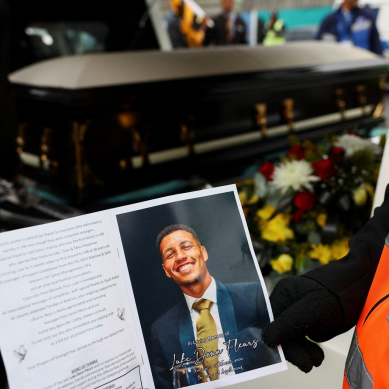
One of the earliest attempts to refute the Wuhan Institute lab link theory was the publication of a statement in The Lancet on February 19, 2020, by Jeremy Farrar, then-director of the Wellcome Trust and Peter Daszak, president of the EcoHealth Alliance, characterising assertions regarding a possible lab accident at Wuhan as a “conspiracy theory.”
Investigative journalist Paul D. Thacker noted that several of the 27 scientists – including Daszak – who signed the statement omitted reporting their ties to EcoHealth Alliance, which funded research at the Wuhan lab. It was later revealed that 26 of the 27 signatories of the statement had ties to the Wuhan Institute of Virology.
Leading up to the publication of the statement, Daszak was working on getting researchers to come on board as co-signatories. However, in an email he sent to some other virologists on February 6, he recommended they not sign the statement “so it has some distance from us and therefore doesn’t work in a counterproductive way.”
In a separate email to Ralph Baric of the University of North Carolina, Daszak wrote: “We’ll then put it out in a way that doesn’t link it back to our collaboration so we maximize an independent voice.”
A week later, a February 26, 2020, commentary in Emerging Microbes & Infections repeated claims that lab-leak theory was a conspiracy theory. The paper was written by virologists – including Linda Saif, of Ohio State University – working behind the scenes with Baric and Shi Zhengli, who conducted research at the Wuhan Institute of Virology.
“Currently, there are speculations, rumours and conspiracy theories that SARS-CoV-2 is of laboratory origin,” the commentary stated.
Two weeks prior, on February 12, 2020, “One of the authors forwarded an email from Ralph Baric that included his comments and changes to the essay’s text, although Baric wrote that he wanted to hide his involvement,” Thacker wrote.
“Don’t want to be cited in as having commented before submission,” Baric wrote.
Yet, on February 16, the commentary’s authors exchanged private concerns that some samples of viruses from the Wuhan Institute of Virology “may not have been handled properly and leaked out of the lab … but that’s just a possibility.”
The acknowledgment came even as the authors were exchanging comments with Zhengli about the paper.
However, “The essay did not disclose the authors’ private concerns that the Covid virus could have come from the lab, nor that Ralph Baric and Shi Zhengli had secretly helped to edit and write the paper,” Thacker wrote. “The essay was downloaded 75,000 times — the third-most downloaded article of 2020 for publisher Taylor and Francis.
The most influential paper of all was published on March 17, 2020. Sometimes referred to as “Proximal Origins,” the paper, authored by Andersen and two other virologists concluded that a lab leak was not “plausible.” A month earlier, Fauci and Collins had reviewed drafts of the paper.
On February 17, Farrar emailed the virologists working on the paper to ask them to make a last-minute change to the draft, from “It is unlikely” to “It is improbable that SARS-CoV-2 emerged through laboratory manipulation of an existing SARS-related coronavirus.” Separately, Farrar said he would “push Nature” to accept the paper.
And on March 8, Andersen emailed Fauci and Collins a new draft of “Proximal Origins,” thanking them for “their ‘advice and leadership’ on the paper,” Thacker wrote, adding that Fauci and Collins were invited “to comment and offer suggestions.”
“The paper made no mention of Jeremy Farrar’s edits to the manuscript, nor of the “advice and leadership” Fauci and Collins provided. The “Proximal Origins” paper became the most cited scientific manuscript of 2020. Several days later, Fauci’s institute approved a multi-million dollar grant for Andersen,” Thacker added.
A promotional campaign for “Proximal Origins” followed, including in a March 26 post by Collins for the NIH Director’s Blog, where he wrote: “Some folks are even making outrageous claims that the new coronavirus causing the pandemic was engineered in a lab” and that “A new study debunks such claims by providing scientific evidence that this novel coronavirus arose naturally.”
“Published in scientific journals, these three papers silenced debate about the origin of the COVID virus, as science writers then began reporting that any question of a Wuhan lab accident was a ‘conspiracy theory,’” Thacker wrote.
Fauci and other key virologists also “began campaigning inside the intelligence community to shut down any inquiry into a possible Chinese lab accident, later admitting they had briefed officials from the State Department, FBI and the CIA,” Thacker wrote.
“Virologists and government scientists then widely promoted these three papers in the media during the initial months of the pandemic, silencing debate about NIH funding in Wuhan, where a lab accident could have started the Covid outbreak,” he said.
The media quickly jumped on board, according to Thacker. “Science reporters began trumpeting the line that a lab accident in Wuhan was a ‘conspiracy theory’ and social media companies began to censor reports about a Chinese lab accident,” he wrote.
Indeed, Fauci took to the media to describe questioning about the lab-leak theory as conspiracy theories and “attacks.”
In a February 9, 2020, podcast, Fauci told former Speaker of the House Newt Gingrich “I’ve heard these conspiracy theories. And like all conspiracy theories, Newt, they’re just conspiracy theories,” adding that “the things you’re hearing are still in the realm of conspiracy theories without any scientific basis.”
Separately, Fauci told NBC, “A lot of what you’re seeing as attacks on me, quite frankly, are attacks on science. Because all of the things that I have spoken about, consistently from the very beginning, have been fundamentally based on science.”
Thacker cited several examples of what he called “complicit media,” including a Time magazine profile of Zhengli, a Scientific American essay calling claims of a lab leak “evidence free,” and a Nature Magazine article calling the lab-leak theory “conjecture.”
One New York Times reporter, Apoorva Mandavilli, tweeted in May 2021: “Someday we will stop talking about the lab leak theory and maybe even admit its racist roots. But alas, that day is not yet here.”
According to Thacker, when a September 2021 preprint study argued that viruses most closely related to Covid-19 were identified in Laos, “science writers at Nature, Science Magazine and the New York Times science desk hopped all over findings to promote a message that Covid-19 likely arose from a virus in Laos.”
This reporting was undermined by internal government documents that showed researchers had been “shipping viruses, for many years, from Laos to the Wuhan Institute of Virology for research” and by evidence provided in a study by the Wuhan lab itself that they had been collecting such viruses from Laos and China since 2006.
More recently, this evidence was further bolstered following the revelation that, under Fauci’s leadership, an NIH-run lab in Montana infected 12 Egyptian fruit bats with a ‘SARS-like’ virus called WIV1, imported from Wuhan, in 2018 – a year before the outbreak of COVID-19.
Out of all these outlets, “only the Washington Post later recanted and corrected false reporting that it was a ‘conspiracy theory’ to claim that the Covid-19 virus may have escaped from a laboratory in Wuhan, China,” Thacker wrote.
Even as more evidence about a potential lab leak emerged, crackdowns on such narratives continued — and social media platforms also got into the act.
Indeed, such censorship began early during the pandemic. Thacker cited the example of ZeroHedge, who on February 1, 2020, published an article stating that a Chinese scientist may have been responsible for the Covid-19 lab leak.
In response, Twitter banned ZeroHedge’s account, while emails have revealed that Fauci and Farrar discussed the ZeroHedge story after it was published. ZeroHedge’s account was later reinstated, following an appeal.
- The Defender report / By Michael Nevradakis, based in Athens, Greece, is a senior reporter for The Defender











